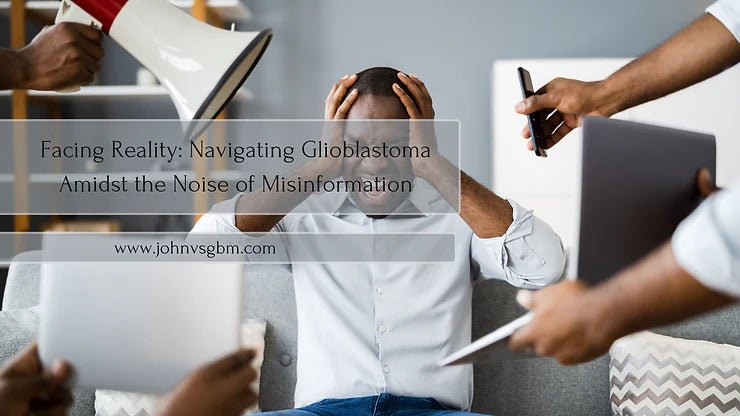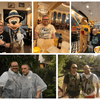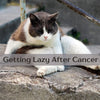Facing Reality: Navigating Glioblastoma Amidst the Noise of Misinformation

Facing Reality: Navigating Glioblastoma Amidst the Noise of Misinformation
Facing Reality: Navigating Glioblastoma Amidst the Noise of Misinformation
I recently read a post on one of the support groups I follow where someone asked if nicotine patches could help cure or treat glioblastoma. This question upset me deeply. Not because the person was wrong for asking, but because it reminded me how misinformation can easily take hold in communities where hope is often the only thing people cling to. In our desperation, we sometimes forget to ask: is this grounded in fact or fiction?
Being the research enthusiast I am, I dug into studies from 2018 to 2021 that tested this theory. The trials were sparse and ultimately disappointing. Nicotine, a known neurostimulant, was being studied for its interaction with certain receptors in glioma cells, but the results did not support any type of practical or beneficial clinical application for glioblastoma. The idea fizzled like so many other miracle cures we have heard about in the cancer world.
The Pattern of False Hope
This reminded me of my days living in San Francisco twenty years ago, when I used to hear stories about HIV/AIDS cures. There were always tales of monkeys in labs or miraculous cases of children being cured overseas. These stories would go viral, especially among communities desperate for good news. And then—nothing. No follow-up. No new standard of care. Just silence. It is a cycle we know too well: hype, hope, and heartbreak.
This cycle is especially dangerous for people living with glioblastoma. Our prognosis is already tough to face. We do not need the added weight of false promises. Still, I understand the urge to cling to anything that offers even a sliver of possibility. Should we try unproven methods in the hope of extending our lives? Or should we face the inevitable and make the most of the time we have?
I do not have all the answers. But I do know that the line between hope and illusion is razor thin—and crossing it too often can leave us more broken than before.
What the Data Says About Glioblastoma
According to the National Cancer Institute SEER database, median survival for glioblastoma has improved from 8–10 months in the 1990s to around 15–18 months today. And while nearly no one survived five years back then, now about 15% do. That is progress. Small, but real.
One thing worth noting: glioblastoma was first recorded in medical literature back in the 1800s. And here we are, still scratching our heads about what causes it. We know a lot more now—about DNA methylation, about the MGMT gene, about IDH mutations—but the core mystery remains. We have extended life a bit, but we have not cracked the code. Not yet.
Optune and the Value of Incremental Progress
The biggest leap in recent memory has been the Optune Gio device, which delivers tumor treating fields directly to the brain. I wear it every day. It is bulky, sometimes uncomfortable, and definitely a conversation starter. But it works—for some. Optune has shown to extend survival when used alongside chemotherapy and radiation, particularly in patients with MGMT-methylated tumors. But again, the numbers are modest. "Significant" in research does not always feel significant when you are the patient. Still, I wear it faithfully. Because every day matters.
My relationship with Optune is complicated. On one hand, I feel like it is saving my life. On the other, I resent how much it reminds me of my diagnosis. But what choice do I have? Every tool that gives me a chance at more time is one I will use. Even if that time is measured in small victories.
Why Misinformation Hurts More Than It Helps
So, let us go back to that nicotine patch post. Why does it bother me so much? Because misinformation does not just waste time—it costs us energy, money, and in some cases, precious hope. When someone invests emotionally in an unproven treatment, only to find out it does not work, the fallout can be devastating. That is time they could have spent building real strength, forging deeper relationships, or just enjoying a good meal with someone they love.
Misinformation distracts from what we know works. It shifts attention from the importance of clean eating, staying hydrated, sleeping well, reducing stress, and pursuing conventional therapy. These are not sexy solutions. They do not go viral. But they are the building blocks of survival and quality of life. Even something as simple as walking 15 minutes a day or journaling your feelings can be transformative. That is what I want us to focus on.
What I Choose Instead
I choose to set goals. Small ones. Manageable ones. Drink more water. Walk the dog. Write this blog. Engage with my support group. Text a friend I have not heard from. These may not cure glioblastoma, but they help me live better while I fight it.
I choose to believe in science—but not blindly. I read medical journals. I ask my neuro-oncologist hard questions. I listen. I advocate for myself. If a treatment sounds too good to be true, I research it. I ask whether it has a randomized control trial. I look at peer-reviewed data. I do not expect miracles, but I will always seek clarity.
And I choose to share my story. Because maybe someone out there is reading this, wondering if they should spend $5,000 on an unproven supplement or fly overseas for a treatment that is not FDA approved. Maybe they are feeling pressure to be positive all the time. Maybe they are tired of everyone telling them to “just have hope.” To them I say: You are not alone. And you do not have to chase magic to be strong.
Moving Forward with Realistic Optimism
Look, I am not saying we should give up. Far from it. But we need to be honest about what we are dealing with. Glioblastoma is relentless. It does not care how brave we are or how many green smoothies we drink. That does not mean we roll over and die. It means we fight smarter. We use what works. We stay informed. We hold space for both fear and courage in the same breath.
And most of all, we live. Not in a state of denial, but with deep, raw honesty. We laugh. We cry. We binge-watch dumb TV shows. We hug our dogs. We breathe in moments of beauty and allow ourselves to feel joy—even if it is fleeting.
Helpful Resources
- NCI Glioblastoma Treatment Overview
- Search Ongoing Glioblastoma Clinical Trials
- More Stories on JohnVsGBM Blog
Tags: Glioblastoma, Brain Cancer, Misinformation, Miracle Cures, Optune, Cancer Research, Clinical Trials, Cancer Blogs, JohnVsGBM
Disclaimer: This blog shares a personal perspective on living with Glioblastoma. It does not provide medical advice. Always consult your physician before making decisions about your care. For emotional support, call or text 988.


 NEW ARRIVALS
NEW ARRIVALS APPAREL
APPAREL GIFT AND HOME
GIFT AND HOME COLLECTION'S
COLLECTION'S HOPE HUB
HOPE HUB BLOG
BLOG



